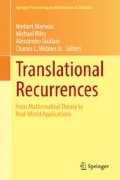Abstract
The feature extraction stage is one of the main tasks underlying pattern recognition, and, is particularly important for designing Brain-Computer Interfaces (BCIs), i.e. structures capable of mapping brain signals in commands for external devices. Within one of the most used BCIs paradigms, that based on Steady State Visual Evoked Potentials (SSVEP), such task is classically performed in the spectral domain, albeit it does not necessarily provide the best achievable performance. The aim of this work is to use recurrence-based measures in an attempt to improve the classification performance obtained with a classical spectral approaches for a five-command SSVEP-BCI system. For both recurrence and spectral spaces, features were selected using a cluster measure defined by the Davies-Bouldin index and the classification stage was based on linear discriminant analysis. As the main result, it was found that the threshold \(\varepsilon \) of the recurrence plot, chosen so as to yield a recurrence rate of 2.5 %, defined the key discriminant feature, typically providing a mean classification error of less than 2 % when information from 4 electrodes was used. Such classification performance was significantly better than that attained using spectral features, which strongly indicates that RQA is an efficient feature extraction technique for BCI.
Access this chapter
Tax calculation will be finalised at checkout
Purchases are for personal use only
References
Wolpaw, J., Wolpaw, E.W.: Brain-Computer Interfacing: Principles and Practice. Oxford University Press, New York (2012)
Wolpaw, J.R., Birbaumer, N., McFarland, D.J., Pfurtscheller, G., Vaughan, T.M.: Brain-computer interfaces for communication and control. Clin. Neurophysiol. 113(6), 767–791 (2002). doi:10.1016/S1388-2457(02)00057-3
Millán, J.R., Rupp, R., Mueller-Putz, G., Murray-Smith, R., Giugliemma, C., Tangermann, M., Vidaurre, C., Cincotti, F., Kubler, A., Leeb, R., Neuper, C., Mueller, K.R., Mattia, D.: Combining brain-computer interfaces and assistive technologies: state-of-the-art and challenges. Front. Neurosci. 4(161), 1–15 (2010). doi:10.3389/fnins.2010.00161
Sobani, Z.A., Quadri, S.A., Enam, S.A.: Stem cells for spinal cord regeneration: current status. Surg. Neurol. Int. 1(1), 93 (2010). doi:10.4103/2152-7806.74240
Zhu, D., Bieger, J., Garcia Molina, G., Aarts, R.M.: A survey of stimulation methods used in SSVEP-based BCIs. In: Computational Intelligence and Neuroscience 2010, 702,357 (2010). doi:10.1155/2010/702357
Marwan, N., Romano, M.C., Thiel, M., Kurths, J.: Recurrence plots for the analysis of complex systems. Phys. Rep. 438(5–6), 237–329 (2007). doi:10.1016/j.physrep.2006.11.001
Marwan, N.: How to avoid potential pitfalls in recurrence plot based data analysis. Int. J. Bifurcat. Chaos 21(4), 1003–1017 (2011). doi:10.1142/S0218127411029008
Zbilut, J.P., Zaldívar-Comenges, J.M., Strozzi, F.: Recurrence quantification based Liapunov exponents for monitoring divergence in experimental data. Phys. Lett. A 297(3–4), 173–181 (2002). doi:10.1016/S0375-9601(02)00436-X
Soriano, D.C., Suyama, R., Ando, R.A., Attux, R., Duarte, L.T.: Blind source separation in the context of deterministic signals. In: Eisencraft, M., Suyama, R., Attux, R. (eds.) Chaotic Signals in Digital Communications, pp. 325–348. CRC Press, Boca Raton (2013). doi:10.1201/b15473-13
Semmlow, J.: Signals and Systems for Bioengineers, 2nd edn. Academic Press, Amsterdam (2011)
Stoica, P., Moses, R.L.: Introduction to Spectral Analysis, Prentice-Hall, Upper Saddle River (1997)
Davies, D.L., Bouldin, D.W.: A cluster separation measure. IEEE Trans. Pattern Anal. Mach. Intell. PAMI–1(2), 224–227 (1979). doi:10.1109/TPAMI.1979.4766909.
Theodoridis, S., Koutroumbas, K.: Pattern Recognition, 2nd edn. Academic Press, New York (1999)
Perez, J.L.M., Cruz, A.B.: Linear discriminant analysis on brain computer interface. In: IEEE International Symposium on Intelligent Signal Processing, 2007. WISP 2007, pp. 1–6 (2007). doi:10.1109/WISP.2007.4447590
Prichard, D., Theiler, J.: Generalized redundancies for time series analysis. Phys. D 84(3–4), 476–493 (1995). doi:10.1016/0167-2789(95)00041-2
Grassberger, P., Procaccia, I.: Measuring the strangeness of strange attractors. Phys. D 9(1–2), 189–208 (1983). doi:10.1016/0167-2789(83)90298-1
Acharya, R., Faust, O., Kannathal, N., Chua, T., Laxminarayan, S.: Non-linear analysis of EEG signals at various sleep stages. Comput. Methods Programs Biomed. 80(1), 37–45 (2005). doi:10.1016/j.cmpb.2005.06.011
Stam, C.J.: Nonlinear dynamical analysis of EEG and MEG: review of an emerging field. Clin. Neurophysiol. 116(10), 2266–2301 (2005). doi:10.1016/j.clinph.2005.06.011
Acknowledgments
L.F.S. Uribe thanks CAPES for financial support. D.C. Soriano and R. Suyama thank UFABC and FAPESP (Grant number 2012/50799-2) for the financial support. F.I. Fazanaro thanks FAPESP (Grant number 2012/09624-4) for the financial support. R. Attux thanks CNPq for financial support. All authors are grateful to FINEP for funding the DesTine project (process number 01.10.0449.00).
Author information
Authors and Affiliations
Corresponding author
Editor information
Editors and Affiliations
Rights and permissions
Copyright information
© 2014 Springer International Publishing Switzerland
About this paper
Cite this paper
Uribe, L.F.S. et al. (2014). A Recurrence-Based Approach for Feature Extraction in Brain-Computer Interface Systems. In: Marwan, N., Riley, M., Giuliani, A., Webber, Jr., C. (eds) Translational Recurrences. Springer Proceedings in Mathematics & Statistics, vol 103. Springer, Cham. https://doi.org/10.1007/978-3-319-09531-8_6
Download citation
DOI: https://doi.org/10.1007/978-3-319-09531-8_6
Published:
Publisher Name: Springer, Cham
Print ISBN: 978-3-319-09530-1
Online ISBN: 978-3-319-09531-8
eBook Packages: Mathematics and StatisticsMathematics and Statistics (R0)

